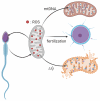Mitochondrial Regulation of Spermatozoa Function: Metabolism, Oxidative Stress and Therapeutic Insights
- PMID: 40805036
- PMCID: PMC12345440
- DOI: 10.3390/ani15152246
Mitochondrial Regulation of Spermatozoa Function: Metabolism, Oxidative Stress and Therapeutic Insights
Abstract
Mitochondria are central to energy production and redox regulation in spermatozoa, supporting key functions such as progressive motility, capacitation, and the acrosome reaction. These processes are essential for successful fertilization and embryo development. However, species-specific differences exist in the reliance on oxidative phosphorylation versus glycolysis. Mitochondria also generate reactive oxygen species, which at physiological levels aid in sperm function but can cause oxidative stress and damage when overproduced. Mitochondrial dysfunction and excessive ROS can impair membrane potential, induce apoptosis, and damage nuclear and mitochondrial DNA, ultimately compromising sperm quality. Sperm mitochondrial DNA is highly susceptible to mutations and deletions, contributing to reduced motility and fertility. Targeted antioxidant strategies have emerged as promising therapeutic interventions to mitigate oxidative damage. This article provides a comprehensive overview of mitochondrial regulation in spermatozoa, the consequences of redox imbalance, and the potential of mitochondria-targeted antioxidants to improve sperm function and male fertility outcomes. The paper aims to deepen our understanding of mitochondrial roles in sperm physiology and contribute to the advancement of strategies for addressing male infertility.
Keywords: antioxidant; energy metabolism; mitochondria; mtDNA; reactive oxygen species; spermatozoa.
Conflict of interest statement
The authors declare that they have no conflicts of interest.
Figures

Similar articles
-
Improving sperm selection strategies for assisted reproduction through closing the knowledge gap in sperm maturation mechanics.Hum Reprod Open. 2025 Jul 3;2025(3):hoaf040. doi: 10.1093/hropen/hoaf040. eCollection 2025. Hum Reprod Open. 2025. PMID: 40698010 Free PMC article. Review.
-
Prescription of Controlled Substances: Benefits and Risks.2025 Jul 6. In: StatPearls [Internet]. Treasure Island (FL): StatPearls Publishing; 2025 Jan–. 2025 Jul 6. In: StatPearls [Internet]. Treasure Island (FL): StatPearls Publishing; 2025 Jan–. PMID: 30726003 Free Books & Documents.
-
Antioxidants for male subfertility.Cochrane Database Syst Rev. 2014;(12):CD007411. doi: 10.1002/14651858.CD007411.pub3. Epub 2014 Dec 15. Cochrane Database Syst Rev. 2014. Update in: Cochrane Database Syst Rev. 2019 Mar 14;3:CD007411. doi: 10.1002/14651858.CD007411.pub4. PMID: 25504418 Updated.
-
Incubation of semen with human follicular fluid improves the antioxidant status and quality of spermatozoa after freezing-thawing.Reprod Fertil. 2025 Jun 26;6(2):e240056. doi: 10.1530/RAF-24-0056. Print 2025 Apr 1. Reprod Fertil. 2025. PMID: 40460191 Free PMC article.
-
Novel insights into the lipid signalling in human spermatozoa.Hum Reprod. 2025 Aug 1;40(8):1440-1451. doi: 10.1093/humrep/deaf085. Hum Reprod. 2025. PMID: 40409756 Free PMC article. Review.
References
-
- Narud B., Klinkenberg G., Khezri A., Zeremichael T.T., Stenseth E.B., Nordborg A., Haukaas T.H., Morrell J.M., Heringstad B., Myromslien F.D., et al. Differences in Sperm Functionality and Intracellular Metabolites in Norwegian Red Bulls of Contrasting Fertility. Theriogenology. 2020;157:24–32. doi: 10.1016/j.theriogenology.2020.07.005. - DOI - PubMed
Publication types
Grants and funding
LinkOut - more resources
Full Text Sources

